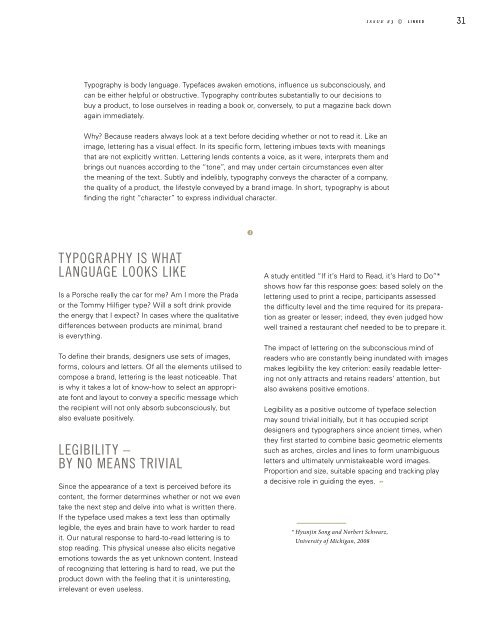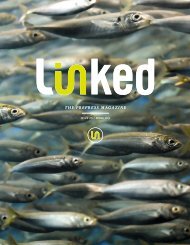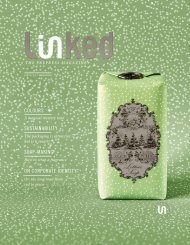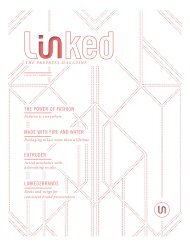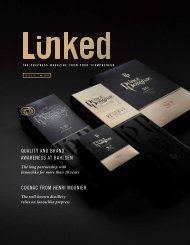Create successful ePaper yourself
Turn your PDF publications into a flip-book with our unique Google optimized e-Paper software.
issue #3 ©<br />
l i n k e d<br />
31<br />
Typography is body language. Typefaces awaken emotions, influence us subconsciously, and<br />
can be either helpful or obstructive. Typography contributes substantially to our decisions to<br />
buy a product, to lose ourselves in reading a book or, conversely, to put a <strong>magazine</strong> back down<br />
again immediately.<br />
Why? Because readers always look at a text before deciding whether or not to read it. Like an<br />
image, lettering has a visual effect. In its specific form, lettering imbues texts with meanings<br />
that are not explicitly written. Lettering lends contents a voice, as it were, interprets them and<br />
brings out nuances according to the “tone”, and may under certain circumstances even alter<br />
the meaning of the text. Subtly and indelibly, typography conveys the character of a company,<br />
the quality of a product, the lifestyle conveyed by a brand image. In short, typography is about<br />
finding the right “character” to express individual character.<br />
Typography is what<br />
language looks like<br />
Is a Porsche really the car for me? Am I more the Prada<br />
or the Tommy Hilfiger type? Will a soft drink provide<br />
the energy that I expect? In cases where the qualitative<br />
differences between products are minimal, brand<br />
is everything.<br />
To define their brands, designers use sets of images,<br />
forms, colours and letters. Of all the elements utilised to<br />
compose a brand, lettering is the least noticeable. That<br />
is why it takes a lot of know-how to select an appropriate<br />
font and layout to convey a specific message which<br />
the recipient will not only absorb subconsciously, but<br />
also evaluate positively.<br />
Legibility –<br />
by no means trivial<br />
Since the appearance of a text is perceived before its<br />
content, the former determines whether or not we even<br />
take the next step and delve into what is written there.<br />
If the typeface used makes a text less than optimally<br />
legible, the eyes and brain have to work harder to read<br />
it. Our natural response to hard-to-read lettering is to<br />
stop reading. This physical unease also elicits negative<br />
emotions towards the as yet unknown content. Instead<br />
of recognizing that lettering is hard to read, we put the<br />
product down with the feeling that it is uninteresting,<br />
irrelevant or even useless.<br />
A study entitled “If it’s Hard to Read, it’s Hard to Do”*<br />
shows how far this response goes: based solely on the<br />
lettering used to print a recipe, participants assessed<br />
the difficulty level and the time required for its preparation<br />
as greater or lesser; indeed, they even judged how<br />
well trained a restaurant chef needed to be to prepare it.<br />
The impact of lettering on the subconscious mind of<br />
readers who are constantly being inundated with images<br />
makes legibility the key criterion: easily readable lettering<br />
not only attracts and retains readers’ attention, but<br />
also awakens positive emotions.<br />
Legibility as a positive outcome of typeface selection<br />
may sound trivial initially, but it has occupied script<br />
designers and typographers since ancient times, when<br />
they first started to combine basic geometric elements<br />
such as arches, circles and lines to form unambiguous<br />
letters and ultimately unmistakeable word images.<br />
Proportion and size, suitable spacing and tracking play<br />
a decisive role in guiding the eyes.<br />
* Hyunjin Song and Norbert Schwarz,<br />
University of Michigan, 2008


